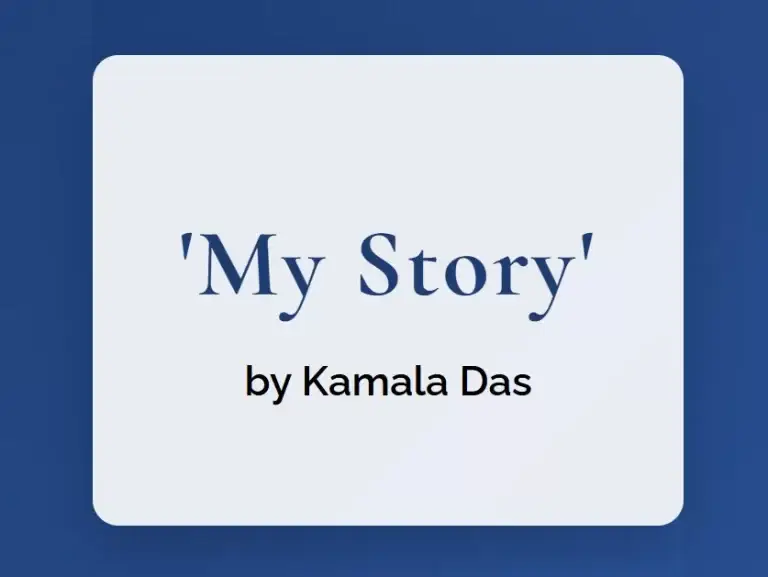When Kamala Das first serialized “Ente Katha” in the Malayalam weekly Malayalanadu, few could have predicted its seismic impact on Indian literature. Writing under the pen name Madhavikutty, she crafted a narrative that would transcend linguistic and cultural boundaries, eventually emerging as the groundbreaking English autobiography “My Story.”
Table of Contents
The Three Personas of a Literary Giant
Madhavikutty: The Malayalam Voice
In her role as Madhavikutty, Das produced some of Malayalam literature’s most compelling short stories and poems. Her work in her mother tongue carried the raw authenticity of lived experience, particularly reflecting her upbringing in Kerala’s sophisticated Nair community.
Kamala Das: The English Iconoclast
As Kamala Das, she emerged as a powerful voice in Indian English literature. Her autobiography challenged the patriarchal structures of Indian society while establishing new paradigms for confessional writing. Consider this passage from “My Story”:
“I always wanted love, and if you don’t get it within your home, you stray a little.”
Kamala Surayya: The Transformed Artist
Her later transformation into Kamala Surayya marked another phase in her artistic evolution, demonstrating the fluidity of identity that characterized both her life and work.
Cultural Contexts and Influences
The Kerala Years
Born into an aristocratic Nair family in Kerala, Das’s early life was steeped in tradition. This background provided both the foundation and the foil for her later literary rebellion:
- Traditional Nair customs shaped her early worldview
- Kerala’s matrilineal system influenced her understanding of gender roles
- Local literary traditions informed her early writing style
The Calcutta Connection
Her time in Calcutta marked a significant turning point:
- Exposure to Bengali intellectual traditions broadened her perspective
- Urban life contrasted sharply with her Kerala upbringing
- The city’s cosmopolitan atmosphere influenced her literary voice
Literary Innovation and Stylistic Mastery
Breaking New Ground
Das revolutionized Indian literature through:
- Bold autobiographical narratives that defied social conventions
- Fearless exploration of feminine desire and sexuality
- Unflinching critique of patriarchal norms and institutions
Linguistic Virtuosity
Her mastery across languages showcased:
- Seamless code-switching between cultural contexts
- Adaptation of Malayalam literary devices in English writing
- Creation of a unique voice that transcended linguistic boundaries
Synopsis: My Story by Kamala Das
Essential Narrative Overview
“My Story” begins in Kerala, where Kamala Das was born into an aristocratic Nair family. The autobiography traces her journey from a precocious young girl to a child bride at sixteen, through her early years of marriage and eventual emergence as a prominent literary figure. Written while Das believed she was dying, the narrative carries an urgent authenticity that became its hallmark.
Marriage and Early Struggles
The text poignantly describes Das’s early marriage to an older man, exploring her confusion and displacement as she moves between Kerala and Calcutta. Her husband’s emotional distance and her own awakening desires create a powerful tension throughout the narrative. These experiences in Calcutta shape her understanding of love, sexuality, and personal identity.
Artistic Awakening
Das details her evolution as a writer, first publishing as Madhavikutty in Malayalam and later as Kamala Das in English. The autobiography, initially serialized in Malayalanadu, chronicles her growing consciousness as an artist and her struggle to find her voice amid societal constraints. Her writing becomes both escape and rebellion.
Cultural Navigation
Threading through the narrative is Das’s complex relationship with her Nair heritage. She simultaneously embraces and challenges traditional values, creating a nuanced portrait of cultural identity. Her experiences moving between Kerala’s traditional society and Calcutta’s urban landscape illuminate the tensions of modernizing India.
Love and Sexuality
Perhaps the most controversial aspects of “My Story” are its frank discussions of love, desire, and sexuality. Das writes openly about her emotional needs, her extramarital relationships, and her quest for authentic connection. These revelations scandalized conservative Indian society while establishing new precedents for women’s confessional writing.
Legacy and Impact
The autobiography closes with reflections on the author’s literary journey and personal growth. Originally published as “Ente Katha” in Malayalam, the work’s translation and publication in English as “My Story” expanded its influence, making it a foundational text in Indian feminist literature and autobiographical writing.
Technical Analysis of “My Story”
Narrative Structure
The autobiography employs sophisticated storytelling techniques:
- Non-linear chronology reflecting memory’s fluid nature
- Interweaving of past and present perspectives
- Strategic use of flashback and foreshadowing
Stylistic Elements
Das’s prose demonstrates remarkable craftsmanship:
- Poetic imagery enriching autobiographical narrative
- Metaphorical language drawing from nature and mythology
- Rhythmic prose reflecting her poetic sensibilities
Thematic Analysis
Identity and Selfhood
The work explores multiple dimensions of identity:
- Personal evolution from arranged marriage to artistic independence
- Navigation between traditional and modern worlds
- Exploration of feminine sexuality and desire
Social Critique
Das’s autobiography serves as a powerful commentary on:
- Conservative Nair community values and constraints
- Gender roles in mid-20th century India
- Marriage institutions and female autonomy
Cultural Impact and Legacy
Literary Influence
“My Story” has shaped Indian literature through:
- Pioneering confessional writing in Malayalam literature
- Influencing subsequent generations of feminist writers
- Establishing new paradigms for autobiographical expression
Social Change
The work contributed to broader social transformations:
- Challenging traditional taboos around female sexuality
- Inspiring women to share their personal narratives
- Questioning established social hierarchies
Critical Reception and Discourse
Contemporary Response
Initial reactions to the work varied dramatically:
- Conservative criticism from traditional quarters
- Celebration by progressive literary circles
- Complex response from feminist scholars
Modern Interpretation
Current scholarship examines:
- Intersection of personal and political narratives
- Role of autobiography in social change
- Linguistic innovation in bilingual writing
Conclusion: A Testament to Literary Courage
Kamala Das’s “My Story,” from its origins as “Ente Katha” to its current status as a masterpiece of Indian literature, represents more than just an autobiography. It stands as a testament to literary courage, artistic innovation, and the power of personal narrative to effect social change. Her journey from Kerala to Calcutta, from traditional Nair values to revolutionary self-expression, creates a narrative that remains relevant and powerful in contemporary discourse.
Resources for Further Study
Primary Texts
- Original Malayalam version (Ente Katha)
- Historical context and publication details
- Comparative analysis with English translation
- Critical reception in Malayalam literary circles
- English translation (My Story)
- Translation history and challenges
- Cultural adaptation considerations
- Impact on English-language readers
- Collections of short stories
- Thematic connections to autobiography
- Stylistic evolution across genres
- Influence on contemporary writers
Critical Works
- Literary analyses
- Feminist interpretations
- Postcolonial readings
- Linguistic studies
- Cultural studies
- Gender and sexuality analysis
- Social impact assessment
- Historical context examination
Explore More of Kamala Das’s Poetic Universe
Dive deeper into Kamala Das’s remarkable poetic landscape with these carefully curated works that showcase her mastery of confessional poetry and feminist themes:
Identity and Defiance
- An Introduction – Das’s iconic exploration of linguistic identity and gender roles, where personal narrative meets political resistance
- The Freaks – A stark examination of physical intimacy and emotional disconnection in modern relationships
Love and Marriage
- The Looking Glass – An unflinching portrayal of feminine desire and vulnerability
- The Old Playhouse – A powerful metaphor for marital confinement and the loss of individual identity
- Relationship – A nuanced exploration of interpersonal bonds and emotional dependencies
Memory and Time
- Summer in Calcutta – A sensuous celebration of youth and seasonal transformation
- My Mother at Sixty-Six – A touching meditation on aging, mortality, and filial love
Power Dynamics
- The Sunshine Cat – A poignant commentary on female subjugation and resilience
- The Descendant – An intricate exploration of heritage and personal legacy



1 Comment
Pingback: Lincoln's Farewell Address: A Historical Perspective - LitGram by MukeshRishit